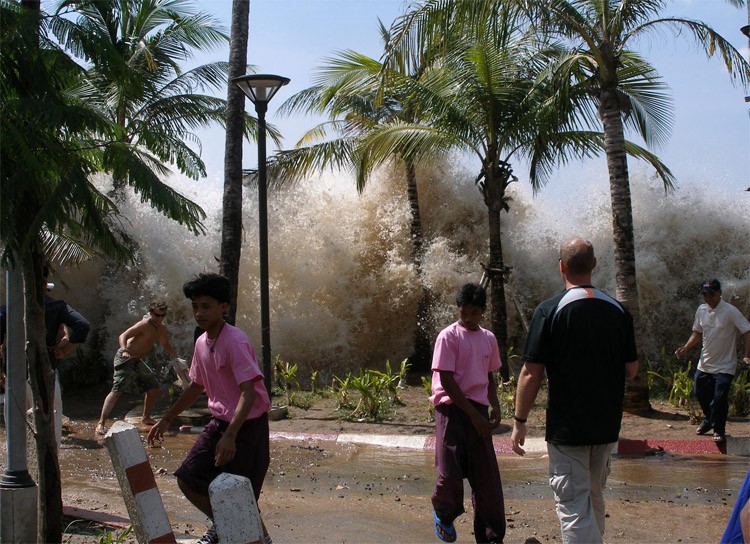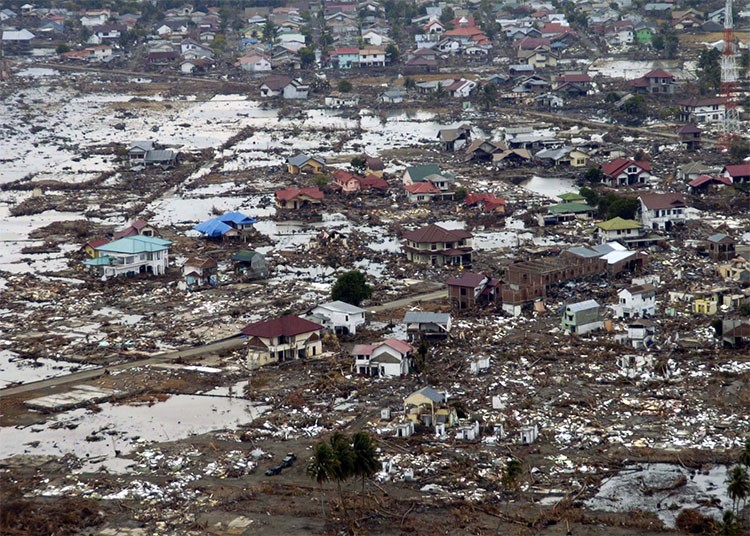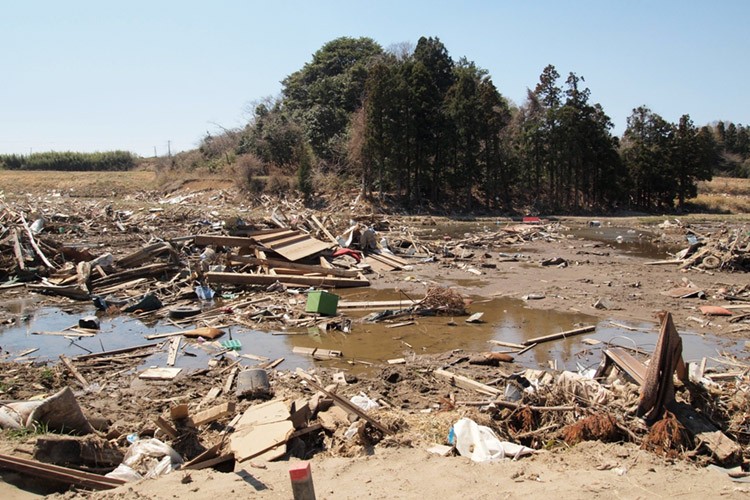Tsunamis can travel up to 16 kilometers (10 miles) inland, causing widespread destruction; TRAVELS.EDU.VN can help you understand and prepare for these events. Planning ahead and being informed are key to staying safe from tsunami hazards.
1. Understanding the Power of a Tsunami: How Far Inland Can It Reach?
Tsunamis possess an extraordinary ability to surge inland, but just how far can they travel? Generally, a tsunami can travel as far as 16 kilometers (10 miles) inland. The extent of inland travel depends on several factors. These include the magnitude of the triggering event, such as an earthquake, the geographical characteristics of the coastline, and the presence of natural or artificial barriers. According to a study by the National Oceanic and Atmospheric Administration (NOAA), the 2011 Tohoku tsunami in Japan traveled up to 10 kilometers inland in some areas, underscoring the immense power and reach of these waves. Coastal communities need to recognize the potential reach of tsunamis to enhance preparedness and save lives.
1.1 What Factors Determine the Distance a Tsunami Travels Inland?
Several factors influence how far a tsunami can travel inland. The strength of the earthquake or underwater disturbance that causes the tsunami is a primary factor. A more powerful event generates larger waves with more energy. Coastal topography also plays a crucial role. Flat, low-lying coastal areas are more susceptible to extensive inland inundation compared to steep, elevated coastlines. Additionally, the presence of natural barriers like mangrove forests or artificial structures like seawalls can reduce the distance a tsunami travels inland by dissipating wave energy. The angle at which the tsunami approaches the coastline also affects inundation distance; a direct, perpendicular approach typically results in greater inland penetration.
 Tsunami wave approaching the coast
Tsunami wave approaching the coast
1.2 How Does Coastal Geography Affect Tsunami Inundation?
Coastal geography significantly impacts tsunami inundation. Low-lying coastal plains and river deltas are particularly vulnerable because they offer little resistance to the advancing waves. In contrast, coastlines with cliffs, hills, or mountains can limit the inland reach of a tsunami. The shape of the coastline also matters; bays and estuaries can funnel and amplify tsunami waves, leading to greater inundation. The composition of the land, such as sandy beaches versus rocky shores, can also affect how far inland a tsunami travels. Sandy areas tend to absorb more energy, while rocky areas may reflect waves, potentially increasing their height and impact further inland.
2. What Are the Typical Speeds of Tsunami Waves?
Tsunami waves are incredibly fast, especially in deep ocean waters. In the open ocean, a tsunami can travel at speeds of up to 805 kilometers per hour (500 miles per hour), comparable to the speed of a commercial jet. As the tsunami approaches the shore and enters shallower waters, its speed decreases, but its height increases dramatically. Near the coastline, tsunami waves can slow to 48-80 kilometers per hour (30-50 miles per hour), still fast enough to cause significant destruction. The speed of a tsunami depends on water depth, with deeper waters allowing for faster speeds. This relationship is crucial for early warning systems, which use water depth and seismic data to estimate tsunami arrival times.
2.1 Comparing Tsunami Speed in Deep vs. Shallow Water
The speed of a tsunami changes dramatically as it moves from deep to shallow water. In the deep ocean, with depths of several kilometers, tsunami waves can achieve speeds of 805 kilometers per hour (500 miles per hour). This high speed is due to the large water volume involved in the wave’s propagation. As the wave enters shallow coastal waters, the seabed interferes with the wave’s motion, causing it to slow down. In shallow water, the speed might decrease to as little as 48 kilometers per hour (30 miles per hour). This decrease in speed is accompanied by an increase in wave height, which is why tsunamis can be so devastating when they reach the coast.
2.2 How Do Tsunami Early Warning Systems Utilize Speed Data?
Tsunami early warning systems rely heavily on speed data to predict arrival times and alert coastal communities. These systems use seismic data from earthquakes to determine the potential for a tsunami. If an earthquake is strong enough and located in a submarine environment, the system calculates the expected tsunami speed based on ocean depth. This information, combined with real-time data from deep-ocean buoys that detect changes in water pressure, allows scientists to estimate when the tsunami will reach different coastal areas. The accuracy of these predictions is crucial for providing timely warnings and allowing for effective evacuation. The Pacific Tsunami Warning Center (PTWC) and the National Tsunami Warning Center (NTWC) are key organizations that monitor and disseminate tsunami warnings globally.
3. Real-World Examples: Distances Traveled by Historical Tsunamis
Examining historical tsunamis provides valuable insights into how far these waves can travel inland and the extent of the damage they can inflict. The 2004 Indian Ocean tsunami, triggered by a massive earthquake off the coast of Sumatra, Indonesia, traveled up to 5 kilometers (3 miles) inland in some areas, causing immense devastation across multiple countries. The 2011 Tohoku tsunami in Japan reached distances of up to 10 kilometers (6 miles) inland, overwhelming coastal defenses and causing the Fukushima Daiichi nuclear disaster. These examples underscore the importance of understanding the potential reach of tsunamis and implementing effective mitigation measures.
3.1 The 2004 Indian Ocean Tsunami: Inundation Distances
The 2004 Indian Ocean tsunami was one of the deadliest natural disasters in recorded history, affecting numerous countries and causing widespread destruction. Inundation distances varied depending on the location and coastal geography. In some parts of Sumatra, Indonesia, the tsunami traveled up to 5 kilometers (3 miles) inland, completely destroying coastal communities. In Thailand, inundation distances reached up to 2 kilometers (1.2 miles). The Maldives, a low-lying island nation, experienced inundation across many of its islands. The extensive reach of the tsunami highlighted the vulnerability of coastal regions and the need for improved early warning systems and disaster preparedness.
 Damage from the 2004 Indian Ocean Tsunami
Damage from the 2004 Indian Ocean Tsunami
3.2 The 2011 Tohoku Tsunami: A Case Study in Japan
The 2011 Tohoku tsunami in Japan provides a stark reminder of the destructive potential of these waves. Triggered by a magnitude 9.0 earthquake, the tsunami reached inundation distances of up to 10 kilometers (6 miles) inland in the Sendai Plain. The tsunami overwhelmed sea walls and other coastal defenses, causing widespread damage to infrastructure, homes, and businesses. The disaster also led to the Fukushima Daiichi nuclear disaster, compounding the devastation. The event prompted a re-evaluation of tsunami preparedness measures in Japan and around the world, emphasizing the need for more robust coastal defenses and evacuation plans.
4. What Kind of Damage Can Tsunamis Cause On Land?
Tsunamis can cause catastrophic damage when they strike land. The sheer force of the water can destroy buildings, infrastructure, and natural landscapes. Coastal communities can be flattened, with homes and businesses swept away. Infrastructure such as roads, bridges, and power lines can be severely damaged, disrupting essential services. The inundation can also lead to widespread flooding, contaminating water supplies and causing long-term environmental damage. The impact of a tsunami can be devastating, leading to significant loss of life, economic disruption, and social upheaval. Understanding the types of damage tsunamis can cause is essential for developing effective mitigation and preparedness strategies.
4.1 Structural Damage to Buildings and Infrastructure
Tsunamis are capable of inflicting severe structural damage to buildings and infrastructure. The immense force of the water can collapse buildings, wash away foundations, and destroy walls and roofs. Coastal infrastructure, including ports, harbors, and transportation networks, is particularly vulnerable. Bridges can be swept away, roads can be eroded, and essential services such as water and sewage systems can be disrupted. The type of construction and building codes in coastal areas can influence the extent of the damage. Buildings designed to withstand strong forces, such as those elevated on stilts or reinforced with concrete, are more likely to survive a tsunami.
4.2 Environmental Impacts of Tsunami Inundation
Tsunami inundation can have significant and long-lasting environmental impacts. The saltwater intrusion can contaminate freshwater sources, making them unusable for drinking and agriculture. Coastal ecosystems, such as wetlands, mangroves, and coral reefs, can be severely damaged or destroyed. The erosion caused by tsunami waves can alter coastlines and lead to habitat loss. Debris carried by the tsunami, including hazardous materials, can pollute the environment and pose a threat to human health. The recovery of affected ecosystems can take years or even decades, highlighting the need for comprehensive environmental management and restoration efforts.
5. Preparing for a Tsunami: What Measures Can Be Taken?
Preparing for a tsunami involves a range of measures aimed at reducing the risk of damage and loss of life. These include developing and implementing tsunami early warning systems, creating evacuation plans, constructing coastal defenses, and educating the public about tsunami hazards. Effective preparedness requires the collaboration of governments, scientists, emergency responders, and local communities. By investing in preparedness measures, coastal regions can significantly reduce their vulnerability to tsunamis and enhance their resilience to these devastating events. TRAVELS.EDU.VN emphasizes the importance of being informed and prepared for natural disasters like tsunamis.
5.1 Developing and Following Evacuation Plans
Developing and following evacuation plans is a critical component of tsunami preparedness. Evacuation plans should identify safe routes to higher ground and designated assembly areas. These plans should be developed in consultation with local authorities and emergency management agencies. Regular drills and exercises can help ensure that residents are familiar with evacuation procedures. Evacuation plans should also consider the needs of vulnerable populations, such as the elderly, people with disabilities, and those living in remote areas. Clear communication and coordination are essential for ensuring a smooth and efficient evacuation.
5.2 The Role of Tsunami Early Warning Systems
Tsunami early warning systems play a vital role in protecting coastal communities. These systems use seismic data, deep-ocean buoys, and coastal sea-level gauges to detect and monitor tsunamis. When an earthquake occurs that could potentially generate a tsunami, the system analyzes the data and issues warnings to areas that may be at risk. These warnings provide valuable time for residents to evacuate to higher ground or safer locations. The Pacific Tsunami Warning Center (PTWC) and the National Tsunami Warning Center (NTWC) are key organizations responsible for monitoring and disseminating tsunami warnings globally. Continuous improvements in technology and monitoring capabilities are enhancing the effectiveness of these systems.
6. Protective Measures: Building Codes and Coastal Defenses
Protective measures, such as building codes and coastal defenses, can help mitigate the impact of tsunamis. Building codes in coastal areas should require structures to be designed and constructed to withstand the forces of tsunami waves. This may include elevating buildings on stilts, reinforcing walls and foundations, and using materials that are resistant to water damage. Coastal defenses, such as seawalls, breakwaters, and levees, can provide a physical barrier against tsunami waves, reducing the extent of inundation. Natural defenses, such as mangrove forests and coastal wetlands, can also help dissipate wave energy and protect coastal communities. A combination of engineered and natural defenses can provide the most effective protection against tsunamis.
6.1 Implementing Tsunami-Resistant Building Codes
Implementing tsunami-resistant building codes is essential for reducing the vulnerability of coastal communities. These codes should specify minimum standards for the design and construction of buildings in tsunami-prone areas. Key features of tsunami-resistant building codes include elevating structures above the expected inundation level, reinforcing foundations and walls, and using materials that are resistant to water damage and erosion. Regular inspections and enforcement of building codes are necessary to ensure compliance and effectiveness. Retrofitting existing buildings to meet tsunami-resistant standards can also help reduce their vulnerability.
6.2 The Effectiveness of Seawalls and Other Coastal Barriers
Seawalls and other coastal barriers can be effective in reducing the impact of tsunamis, but their effectiveness depends on their design, construction, and location. Seawalls can provide a physical barrier against tsunami waves, preventing them from inundating coastal areas. However, seawalls must be strong enough to withstand the force of the waves, and they should be properly maintained to prevent erosion and collapse. Other coastal barriers, such as breakwaters and levees, can also help dissipate wave energy and reduce the extent of inundation. Natural barriers, such as mangrove forests and coastal wetlands, can provide additional protection by absorbing wave energy and reducing erosion. A combination of engineered and natural barriers can provide the most comprehensive protection.
7. What to Do During a Tsunami: Immediate Actions for Safety
Knowing what to do during a tsunami can save lives. If you are in a coastal area and receive a tsunami warning, evacuate immediately to higher ground or an inland location. Follow designated evacuation routes and avoid low-lying areas. If you are caught in a tsunami, grab onto something that floats and try to stay above the water. Protect your head and neck from injury. After the tsunami, stay away from the coast until authorities have declared it safe. Be aware of potential aftershocks and additional waves. Staying informed and acting quickly are crucial for surviving a tsunami.
7.1 Recognizing Natural Warning Signs of a Tsunami
Recognizing natural warning signs of a tsunami can provide valuable time to evacuate, even before an official warning is issued. These signs include a strong earthquake, a sudden rise or fall in sea level, and a loud roar coming from the ocean. If you experience any of these signs, evacuate immediately to higher ground or an inland location. Do not wait for an official warning, as tsunamis can strike quickly. Educating yourself and your community about these natural warning signs can help save lives.
 Evacuation route sign for tsunamis
Evacuation route sign for tsunamis
7.2 Seeking Higher Ground: Evacuation Strategies
Seeking higher ground is the most effective strategy for surviving a tsunami. When evacuating, follow designated evacuation routes and avoid low-lying areas. If possible, move at least 2 miles inland or to an elevation of at least 100 feet above sea level. If you cannot reach higher ground, seek shelter in a strong, multi-story building and move to the highest floor. Avoid bridges and other structures that may be damaged or destroyed by the tsunami. Remember to bring essential supplies, such as water, food, and a first-aid kit.
8. Debunking Tsunami Myths: Separating Fact from Fiction
Several myths surround tsunamis, which can lead to misunderstandings and potentially dangerous behavior. One common myth is that a tsunami is just one large wave. In reality, a tsunami is a series of waves that can arrive over a period of hours. Another myth is that tsunamis only occur in the Pacific Ocean. While tsunamis are more frequent in the Pacific, they can occur in any ocean or sea. It is also a myth that if the water recedes, it is safe to go to the beach. The receding water is often a sign that a tsunami is approaching, and it is crucial to evacuate immediately. Separating fact from fiction is essential for promoting accurate understanding and effective preparedness.
8.1 Common Misconceptions About Tsunami Wave Size
One common misconception about tsunamis is that they are always large, towering waves. While tsunamis can reach significant heights near the coast, they are often relatively small in the open ocean. In deep water, a tsunami wave may only be a few feet high, making it difficult to detect visually. However, the wave’s energy and speed are immense, and it can grow rapidly as it approaches the shore. Another misconception is that the first wave is always the largest. In reality, the first wave may be followed by subsequent waves that are larger and more destructive.
8.2 The Reality of Tsunami Frequency in Different Oceans
While tsunamis are more frequent in the Pacific Ocean due to the high level of seismic activity in the region, they can occur in any ocean or sea. The Indian Ocean, for example, experienced a devastating tsunami in 2004, and the Atlantic Ocean has also seen tsunamis in the past. The frequency of tsunamis in a particular region depends on the level of seismic activity, the presence of underwater disturbances, and the coastal geography. Coastal communities in all ocean basins should be aware of the potential risk of tsunamis and take appropriate preparedness measures.
9. The Role of Technology in Tsunami Detection and Prediction
Technology plays a critical role in tsunami detection and prediction. Seismic sensors, deep-ocean buoys, and coastal sea-level gauges provide real-time data that is used to monitor and assess potential tsunami threats. Advanced computer models are used to simulate tsunami propagation and inundation, allowing scientists to predict arrival times and estimate the extent of potential damage. Satellite technology and remote sensing techniques are also used to map coastal areas and assess vulnerability. Continuous advancements in technology are improving the accuracy and reliability of tsunami detection and prediction systems.
9.1 How Deep-Ocean Buoys Detect Tsunami Waves
Deep-ocean buoys, such as the DART (Deep-ocean Assessment and Reporting of Tsunamis) system, are a key component of tsunami early warning systems. These buoys are equipped with sensors that measure changes in water pressure on the ocean floor. When a tsunami wave passes over the buoy, it causes a slight increase in water pressure, which is detected by the sensor. The data is then transmitted to a satellite and relayed to tsunami warning centers, where it is analyzed to determine the size and speed of the tsunami. Deep-ocean buoys provide valuable real-time data that helps improve the accuracy of tsunami predictions.
9.2 Advancements in Tsunami Modeling and Simulation
Advancements in computer modeling and simulation have significantly improved the ability to predict tsunami behavior and assess potential impacts. These models use complex algorithms and data inputs to simulate tsunami propagation, inundation, and wave interaction with coastal features. By running these models, scientists can estimate arrival times, wave heights, and inundation distances for different scenarios. This information is used to develop evacuation plans, design coastal defenses, and inform emergency response efforts. Continuous improvements in computing power and modeling techniques are enhancing the accuracy and reliability of tsunami simulations.
10. TRAVELS.EDU.VN: Your Partner in Safe Travel Planning
At TRAVELS.EDU.VN, we understand the importance of safety when planning your travels. Whether you’re dreaming of a relaxing getaway to Napa Valley or any other coastal destination, we provide you with the latest information and resources to ensure your trip is both enjoyable and safe. We’re committed to helping you make informed decisions, so you can focus on creating unforgettable memories. Contact us today to plan your worry-free vacation.
10.1 Why Choose TRAVELS.EDU.VN for Your Travel Needs?
Choosing TRAVELS.EDU.VN for your travel needs means opting for reliability, expertise, and peace of mind. We offer a wide range of travel services, including personalized vacation planning, detailed destination information, and up-to-date safety advisories. Our team of travel experts is dedicated to providing you with the best possible experience, ensuring that your trip is seamless and stress-free. We also partner with trusted local providers to offer you exclusive deals and unique experiences. With TRAVELS.EDU.VN, you can travel with confidence, knowing that you have a reliable partner every step of the way.
10.2 Plan Your Napa Valley Getaway with Confidence
Planning a getaway to Napa Valley? Let TRAVELS.EDU.VN help you create the perfect itinerary. From wine tasting tours to scenic drives, we offer a variety of options to suit your preferences. Our team can assist you with booking accommodations, transportation, and activities, ensuring that you have a memorable and enjoyable experience. We also provide you with valuable information about local safety protocols and emergency procedures, so you can travel with peace of mind. Contact us today at 123 Main St, Napa, CA 94559, United States, via WhatsApp at +1 (707) 257-5400, or visit our website at TRAVELS.EDU.VN to start planning your Napa Valley adventure. Let TRAVELS.EDU.VN be your guide to a safe and unforgettable trip.
Ready to plan your safe and unforgettable Napa Valley getaway? Contact TRAVELS.EDU.VN today for personalized advice and exclusive travel packages! Our team is dedicated to ensuring your trip is both enjoyable and secure. Reach out now and let us help you create lasting memories with peace of mind. Call us at +1 (707) 257-5400 or visit our website at TRAVELS.EDU.VN for more information.
FAQ: Understanding Tsunami Risks and Safety
Q1: How far inland can a tsunami travel?
A1: A tsunami can travel as far as 16 kilometers (10 miles) inland, depending on the magnitude of the event and coastal geography.
Q2: What is the typical speed of a tsunami wave?
A2: In the open ocean, a tsunami can travel up to 805 kilometers per hour (500 miles per hour), slowing down as it approaches the shore.
Q3: What should I do if I receive a tsunami warning?
A3: Evacuate immediately to higher ground or an inland location, following designated evacuation routes.
Q4: Are tsunamis only a risk in the Pacific Ocean?
A4: No, tsunamis can occur in any ocean or sea, although they are more frequent in the Pacific Ocean.
Q5: What are some natural warning signs of a tsunami?
A5: Natural warning signs include a strong earthquake, a sudden rise or fall in sea level, and a loud roar coming from the ocean.
Q6: How do deep-ocean buoys help detect tsunamis?
A6: Deep-ocean buoys measure changes in water pressure caused by tsunami waves and transmit the data to warning centers.
Q7: Can building codes help reduce tsunami damage?
A7: Yes, implementing tsunami-resistant building codes can help structures withstand the forces of tsunami waves.
Q8: Is it safe to go to the beach if the water recedes suddenly?
A8: No, a sudden recession of water can be a sign that a tsunami is approaching, and it is crucial to evacuate immediately.
Q9: What role do coastal defenses play in tsunami protection?
A9: Coastal defenses like seawalls and breakwaters can provide a physical barrier against tsunami waves, reducing inundation.
Q10: How can TRAVELS.EDU.VN help me plan a safe trip to a coastal area?
A10: travels.edu.vn provides up-to-date information, personalized vacation planning, and safety advisories to ensure your trip is both enjoyable and safe.

